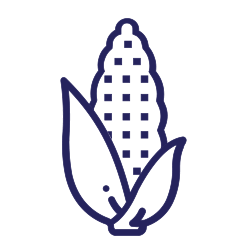Section Title
Weed Management in Winter Wheat
- Winter Wheat
While the winter annual growth habit and rapid spring growth of winter wheat means it can effectively out-compete many weeds, some considerations to weed control should still be made. Herbicides are an important tool, but a variety of other practices can also be implemented to manage weeds in winter wheat crops.
Integrated weed management
There are several integrated weed management practices available to famers that may help encourage the competitive nature of winter wheat:
- Fertilizer management: Nutrient management can be an important aspect of integrated weed management. A number of studies performed in Alberta show that banding nitrogen fertilizer in winter wheat improves uptake by the crop and reduces weed biomass1,2.
- Competitive varieties: While winter wheat is a naturally competitive crop, variety selection can still aid in weed management. Since good crop establishment and vigorous early growth is important for weed suppression, select a variety with a higher winter hardiness rating. In addition, taller winter wheat varieties tend to compete with weeds more effectively than shorter varieties3,4. Consult the latest publication of Seed Manitoba for information on winter wheat variety characteristics.
- Seeding rate: In Manitoba, a target plant population of 20 to 30 plants per square foot is recommended for winter wheat. Higher seeding rates (42 seeds per square foot) have been shown to provide increased weed competition and result in decreased weed biomass3. Under severe moisture-limiting conditions, caution should be taken when using high seeding rates. In the spring, it is important to assess winter survival and plant stand. A field in which winter survival was good will be highly competitive and may not require herbicide application. If the plant stand is below optimum, winter wheat may be able to compensate by increasing tillering, but it will likely require additional weed management.
Herbicide options
Despite using best management practices, herbicides may still be necessary in the fall or spring. If winterkill occurs, the competitiveness of the crop will be impacted and more intensive weed management may be needed. Winter annual weeds, such as stinkweed, shepherd’s purse, downy brome and Japanese brome, can be particularly challenging in winter wheat.
When applying herbicides, be aware of the maximum winter wheat growth stage on the herbicide label to avoid damage to the crop. Application of some herbicides when the crop is stressed due to cold temperatures, drought or frost can also increase the risk of crop damage and will reduce the efficacy of the herbicide. There are several opportunities for herbicide application in winter wheat:
- Pre-seeding or pre-emergence: In winter wheat, as in many other crops, pre-seed or pre-emergence herbicides are an effective way to control problem perennial and winter annual weeds and set your crop up for successful stand establishment. Glyphosate is often an effective choice, but other products may be used or added to glyphosate as a tank mix.
- Fall in-crop: If winter annual weeds are an issue, but were not controlled prior to emergence, the most effective time for control is in the fall prior to freezing. These weeds emerge in the fall and resume growth very early in the spring, making them difficult to control later in the spring.
- Spring in-crop: Begin scouting winter wheat fields early to assess the need for spring application of herbicides. Many winter annual weeds resume growth very early in the spring and the early growth habit of winter wheat means the safe application window for many herbicides could pass before spring seeding of other crops is complete. It is important to note, however, that many herbicides must be applied when weeds are actively growing. Spraying before weeds have resumed growth will be less effective. For more information on assessing winter wheat survival, see our past article here.
Control of annual bromes
Winter annual grasses, such as downy and Japanese brome, can be very competitive in winter wheat and have the potential to cause significant yield losses if they remain uncontrolled.
When choosing an herbicide for control of bromes, it is important to be aware of which species is present, as downy brome is more challenging to control than Japanese brome and some herbicide options may not control both species. For identification characteristics of Japanese and downy brome, the government of Saskatchewan has a helpful guide here.
Limited in-crop options exist for the control of bromes in winter wheat, but several chemistries are available. In a study performed in Alberta, pyroxsulam-containing herbicides (Simplicity™) applied in the fall post-emergence provided greater than 70 per cent and 90 per cent control of downy and Japanese brome, respectively, while flucarbazone and thiencarbazone provided control that was slightly less efficient5. Consult the Guide to Field Crop Protection for a complete list of herbicide options.
Herbicide resistance is also an emerging issue for downy brome. Plants with resistance to Group 1 and Group 2 herbicides have been found across the western United States, and downy brome with resistance to glyphosate was found in Alberta in 2021. To prevent the development of herbicide resistance, consider using tank mixes and rotating herbicide groups/site of action, as well as maintaining a diverse crop rotation.
In winter wheat, as in all crops, weed control must include a variety of management practices to ensure the crop is healthy and productive, while reducing the risk of developing herbicide-resistant weeds. Maximizing the competitive nature of winter wheat, combined with wise use of herbicides, will allow for an effective weed management plan.
Additional resources
Manitoba Agriculture:
- Guide to Field Crop Protection
- Integrated Weed Management – Making it Work on Your Farm
- Winter Wheat – Production and Management
Invasive Species Council of Manitoba:
Government of Saskatchewan:
References
- Blackshaw, R. E., Molnar, L. J. & Larney, F. J. Fertilizer, manure and compost effects on weed growth and competition with winter wheat in western Canada. Crop Prot. 24, 971–980 (2005).
- Beres, B. L. et al. Influence of N fertilization method on weed growth, grain yield and grain protein concentration in no-till winter wheat. Can. J. Plant Sci. 90, 637–644 (2010).
- Beres, B. L. et al. A sustainable management package to improve winter wheat production and competition with weeds. Agron. J. 102, 649–657 (2010).
- Beres, B. L. et al. Weed-competitive ability of spring and winter cereals in the northern Great Plains. Weed Technol. 24, 108–116 (2010).
- Johnson, E. N. et al. Pyroxasulfone is effective for management of Bromus spp. in winter wheat in Western Canada. Weed Technol. 32, 739–748 (2018).














